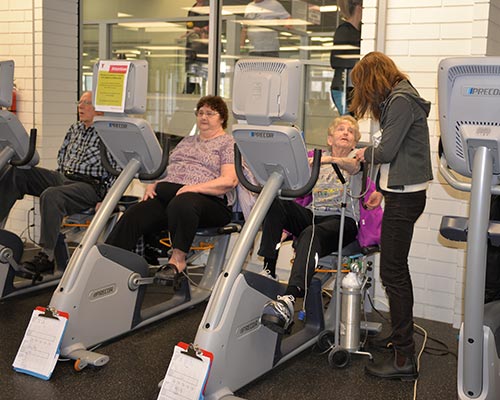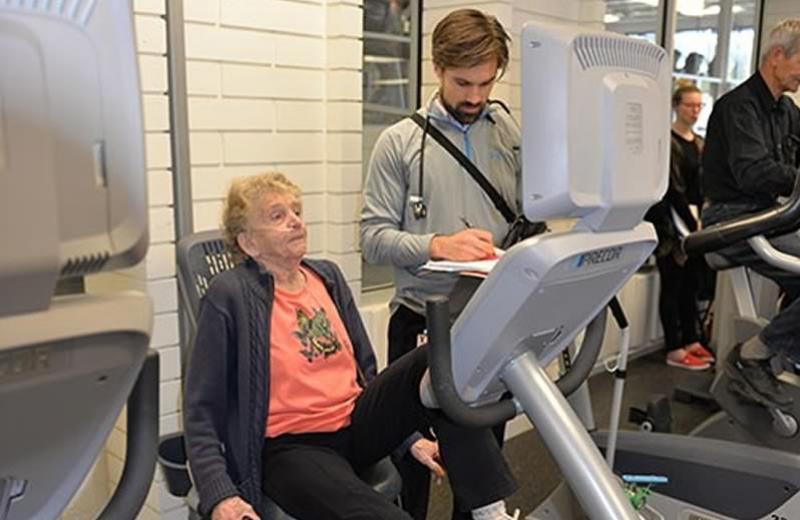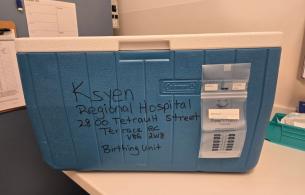Chronic obstructive pulmonary disease (COPD)
When Dianne Gagne first arrived to take part in the new pulmonary rehabilitation program in Prince George, she had to stop twice to catch her breath en route from the parking lot of the YMCA to the room inside where the program is run. "I couldn't even shower without getting short of breath," shared Gagne, whose shortness of breath is caused by chronic obstructive pulmonary disease (COPD) and other complications stemming from a fungal infection of her lungs that first appeared in her 20s.
Robin Roots, a physiotherapist, has seen this before. "For many people with a diagnosis of chronic pulmonary disease," said Roots, "simply going to Walmart is not an option because of the walking requirement. They are left winded, short of breath, and unable to function."
Pulmonary rehabilitation program improving quality of life
It is these challenges and more that the pulmonary rehabilitation program – a partnership between the YMCA of Northern BC, the UBC Department of Physical Therapy, and Northern Health – is working to address. And so far, as Dianne Gagne can attest, it seems to be working. "By the end, I could park and walk up to the room," said Gagne. "I may never have my full lung function back – I was once an avid cross-country skier – but I'm noticing improvements. I can now do my daily chores without any issues and I'm walking for a full half-hour on the treadmill."
Pulmonary rehabilitation is a well-established, well-researched intervention to help people with chronic pulmonary diseases cope with shortness of breath, develop activity tolerance, and improve quality of life. Pulmonary rehabilitation includes both an exercise component and education relating to proper disease management delivered by a team of health professionals, including physiotherapists, exercise physiologists, pharmacists, dietitians, respiratory therapists, and specialists.
"Exercise is really the distinguishing feature of this specialized program," said Roots. "Each participant is assessed and receives an individualized program which is fully supervised. Participants take part in high intensity lower limb aerobic training, strengthening, and balance exercises. Because most participants are on oxygen and many are quite deconditioned, this exercise needs to be very closely monitored. We've got some participants on bicycles, some on arm cycles, some on treadmills. It's all about understanding how much their body can do and designing exercises that increase their ability to take on daily living activities."
For Gagne, the individualized program really stood out. "They scrutinize you very carefully," said Gagne. "They would measure my oxygen levels, pulse, and blood pressure before and after exercises. If my oxygen saturation would fall below a certain level, the physiotherapists would stop me. They didn't push me to do more than I could, but they did challenge me to do as much as I could! The exercise regimes they develop are specific to each individual. Some people were doing 2-3 minutes of activity, others were doing 45. The physiotherapists and students explain things at every step – they would tell me why I would be doing certain exercises."
The program is a preventive measure
The pulmonary rehabilitation program has clearly had a positive impact on Gagne and the other participants. "Participants set their own goals," said Roots, "and we try to get them there." For many, the goal is simply to be able to better manage shortness of breath and to function day-to-day without getting short of breath – goals which can significantly improve quality of life. For Roots, however, the research points to an important system level benefit of the pulmonary rehabilitation program. "Research has shown that pulmonary rehabilitation can decrease emergency room visits for acute acerbations of COPD by 40 per cent. We know that there are approximately 300 hospitalizations for COPD per year in Prince George and that the average length of stay for someone with an acute exacerbation is nine days. There is also a readmission rate of 13 per cent. If we can reduce the number of ER visits and prevent hospitalizations, we can save the system a lot of resources."
Gagne agreed: "This program is a preventive measure. It keeps you out of the hospital and teaches you how to look after your condition on your own."
The pulmonary rehabilitation program in Prince George is an eight week program, with a cohort of 10-15 participants getting together twice weekly for exercises and education. Anyone with a diagnosis of chronic pulmonary disease can join the program, you just need to complete a pulmonary function test. You can access the rehabilitation program through your physician – ask them about it or tell them about it! Participants have come from as far as Smithers and work is underway to look at how the program can be made more accessible to people living outside of Prince George.
According to Roots, the pulmonary rehabilitation program in Prince George, which has received a lot of support from local respirologists Dr. Sharla Olsen and Dr. John Smith, is unique for a few reasons:
- It represents a partnership between three organizations (a partnership that has also created a second program: cardiac rehabilitation).
- UBC trains physiotherapy students in Northern BC and the rehabilitation program offers a valuable site for clinical placements ("It's win-win," said Roots). The students provide a valuable service to the program participants while at the same time being trained under the supervision of a licensed physiotherapist.
- While many pulmonary rehabilitation programs are run out of hospitals, this program is based in the community. This can help encourage participants to think about maintaining the gains they make in the program through active lifestyle opportunities right in the community.
- The partnership has allowed for the program to be offered at very low cost to participants – just a $10 membership fee.
Both Roots and Gagne have a similar goal: they want more people to know about the program! With one in four people likely to develop COPD in Northern BC, pulmonary rehabilitation programs have the potential to have a massive impact.
"Without the program," reflected Gagne, "I would be sitting at home, continually going downhill. And though these changes take time, I keep telling my doctors how fantastic the program was. I would like for more people to know about this program – it is available and is really helpful."
COPD Support Group
Many participants in the pulmonary rehabilitation program see each other one more time each week through the Prince George COPD Support Group. I asked the group to tell me a bit about themselves and this is what the group's treasurer, Nancy, shared:
The Prince George COPD Support Group, also known as the SOBs (Short of Breaths) gives those diagnosed with COPD (and any other lung issues) a place to learn how to cope with an unforgiving disease. Our group gets exercise directions from a licensed physiotherapist, who also gives informative chats on various issues related to the lungs. As members are all living with the same issues, we have a wealth of lay knowledge to fall back on and share with each other. We have coffee days where we often bring in speakers on a variety of subjects, which goes a long way towards educating us all. We are a dedicated group of boomers helping others as they help us. We are a fun group and invite new members to join – bringing a friend or family member is always welcome!
The group meets every Wednesday, 1 pm to 3 pm in the AiMHi Gymnasium in Prince George (950 Kerry Street).
What you need to know: Chronic Obstructive Pulmonary Disease (COPD)
Although COPD is the most prevalent condition amongst pulmonary rehabilitation program participants, the program accepts people with any chronic pulmonary disease. Ask your doctor about pulmonary rehabilitation.

From HealthLinkBC.ca:
- COPD is a lung disease that makes it hard to breathe.
- COPD is most often caused by smoking. Other possible causes include long-term exposure to lung irritants, neonatal lung disease, and genetic factors.
- COPD gets worse over time. While you can’t undo the damage to your lungs, you can take steps to prevent more damage and to feel better.
- The main symptoms are a long-lasting cough, mucus that comes up when you cough, and shortness of breath.
- At times, symptoms can flare up and become much worse. This is called a COPD exacerbation and can range from mild to life-threatening.
According to the Canadian Lung Association, "chronic lung disease accounts for more than 6% of annual health-care costs in Canada, and COPD is the leading cause of hospitalization." COPD is the fourth leading cause of death in Canada. The Canadian Thoracic Society reports that a 2008 study "conservatively estimated the total cost of COPD hospitalizations at $1.5 billion a year."
A version of this article was originally published in the summer 2017 issue of Healthier You magazine. Read the full issue – all about healthy lungs – on ISSUU!














Comments
Anonymous says